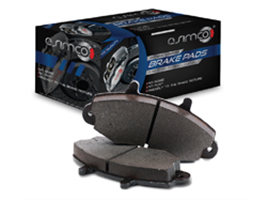-28%
Get Front Brake Pad KD2770 Asimco Toyota Ipsum
Brake pads are essential components of a vehicle’s braking system, responsible for converting kinetic energy into heat through friction. This friction slows down or stops the vehicle by pressing against the brake rotors (discs). Understanding the functions, types, materials, and maintenance of brake pads is crucial for maintaining vehicle safety and optimal braking performance.
Functions of Brake Pads
- Friction Generation: The primary function of brake pads is to create friction against the brake rotors when the brake pedal is pressed. This friction converts kinetic energy into heat, which slows down the rotation of the wheels and brings the vehicle to a stop.
- Heat Dissipation: Brake pads are designed to dissipate the heat generated during braking efficiently. Proper heat management prevents brake fade (reduced braking efficiency due to overheating) and ensures consistent braking performance.
- Noise Reduction: High-quality brake pads incorporate features such as chamfers, slots, and shims to minimize noise during braking. These design elements reduce vibrations and prevent squealing or squeaking noises.
- Wear Resistance: Brake pads are engineered to withstand the high temperatures and pressures generated during braking. They are designed to wear evenly and provide consistent performance throughout their lifespan.
Types of Brake Pads
- Non-Metallic Organic Brake Pads: Made from organic materials such as rubber, glass, and Kevlar, bound together with resin. Organic brake pads are quiet, produce less dust, and are gentle on brake rotors. They are suitable for everyday driving but may wear faster under heavy use.
- Semi-Metallic Brake Pads: Contain metal fibers (steel, iron, copper) mixed with organic materials. Semi-metallic pads offer excellent braking performance, durability, and heat dissipation. However, they can be noisier and produce more brake dust compared to non-metallic organic pads.
- Low-Metallic NAO (Non-Asbestos Organic) Brake Pads: These pads contain a small percentage of metal (typically 10-30%), combined with organic materials. Low-metallic NAO pads provide improved braking performance and durability compared to organic pads. They can be noisier and produce more dust than non-metallic organic pads.
- Ceramic Brake Pads: Made from ceramic fibers, nonferrous filler materials, and bonding agents. Ceramic pads offer superior braking performance, excellent heat dissipation, and reduced noise and dust compared to other types. They are ideal for high-performance vehicles and everyday driving.
Materials Used in Brake Pads
- Friction Materials: The friction surface of brake pads is typically made from various materials, including organic compounds, semi-metallic materials (metal fibers), ceramic fibers, and sometimes carbon composite materials. These materials are chosen for their ability to provide consistent friction characteristics, durability, and heat resistance.
- Backing Plate: The backing plate of brake pads is usually made from steel or other metals. It provides structural support and rigidity to the brake pad assembly, ensuring proper fitment and stability within the brake caliper.
- Bonding Agents: Resins and adhesives are used to bond the friction materials to the backing plate. High-quality bonding agents ensure that the friction material remains securely attached to the backing plate under all operating conditions.
Importance of Brake Pad Maintenance
- Regular Inspection: Periodically inspect brake pads for wear and tear. Most brake pads have wear indicators (small metal tabs) that squeal against the rotor when the pads are worn down, signaling the need for replacement.
- Timely Replacement: Replace brake pads according to the manufacturer’s recommended intervals or when signs of wear are evident. Delaying replacement can lead to damage to other brake components and compromise braking performance.
- Quality Replacement Parts: Use high-quality brake pads that meet or exceed OEM specifications. Quality pads ensure reliable performance, reduced noise, and longer lifespan.
- Proper Bedding Procedure: When installing new brake pads, follow the manufacturer’s recommended bedding-in procedure. This process ensures that the brake pads and rotors mate properly, optimizing braking efficiency and preventing uneven wear.
Replacement Process
- Lift and Secure the Vehicle: Use a jack to lift the vehicle and secure it with jack stands. Remove the wheels to access the brake components.
- Remove Old Brake Pads: Depending on the brake system design, you may need to unbolt the brake caliper and carefully remove the old brake pads. Take note of any clips, shims, or hardware that needs to be transferred to the new pads.
- Prepare Caliper and Install New Pads: Clean the brake caliper and rotor surfaces with brake cleaner. Install the new brake pads into the caliper bracket or housing, ensuring they are seated correctly.
- Reassemble and Test: Reinstall the brake caliper over the new pads and rotor. Secure the caliper bolts to the manufacturer’s torque specifications. Reinstall the wheels, lower the vehicle, and perform a test drive to ensure proper brake operation.
Follow us on Facebook for more parts.

